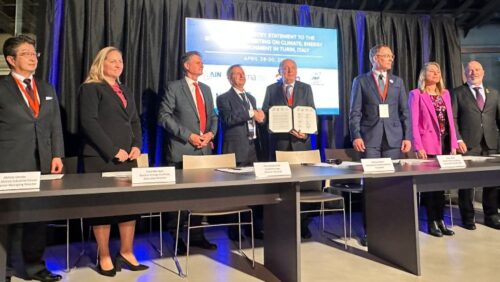
Canadian nuclear industry welcomes leadership by premiers in paving the way for Small Modular Reactor deployment in Canada
OTTAWA (April 14, 2021) – The Canadian Nuclear Association (CNA) congratulates the premiers of Ontario, New Brunswick and Saskatchewan for taking the next step forward in ensuring Canada becomes a global leader in the development and deployment of SMR technology with the release of the SMR feasibility study.
We also applaud today’s news that Alberta has formally joined the other three provinces by signing the SMR Memorandum of Understanding (MOU). This is a crucial step in Canada’s energy transition because SMRs produce the density of electricity and heat needed to maximize the potential of all other energy sources.
On December 1, 2019, the provinces of New Brunswick, Saskatchewan and Ontario signed a MOU that puts in place a framework for action on the deployment of SMRs in their respective jurisdictions.
As set out in the MOU, a feasibility study, ‘Feasibility of Small Modular Reactor Development and Deployment in Canada’, was prepared by Ontario Power Generation (OPG), Bruce Power, New Brunswick Power (NB Power), and Saskatchewan Power (SaskPower) for the governments of Saskatchewan, Ontario and New Brunswick that includes the business case for the development and deployment of SMRs in their respective jurisdictions. The power companies assess that SMRs have the potential to be an economically competitive source of energy in their respective provinces.
The next step will be the development of a strategic plan for deployment of SMRs. This plan will identify steps required to achieve project commitments in a timely manner, while identifying economic impacts, key risks, mitigation measures, as well as the policy and regulatory analysis required to enable and govern expanded deployment of nuclear technology in Canada.
SMRs are nuclear reactors that produce 300 megawatts (MW) of electricity or less. Much smaller than traditional nuclear power plants, SMRs are less expensive to mass produce and easier to deploy. Their modular design allows for deployment in large established grids, small grids, remote off-grid communities and as an energy source for resource projects. SMRs provide a source of safe, clean, affordable energy, with the ability to contribute towards a resilient, low-carbon future.
Learn more about the SMR Feasibility Study here.
Quotes
“We will only meet climate change goals through a swift transition to clean energy sources. This will require the adoption of existing and emerging low-carbon technologies, including small modular reactors,” said John Gorman, President and CEO of the Canadian Nuclear Association. “In fact, for a successful clean energy transition, new nuclear must play a lead role. Initiatives like those announced today build momentum for Canada as a global leader in the development and deployment of these important technologies.”
“Nuclear energy is a cornerstone of New Brunswick’s diverse generation mix and is a key resource when transitioning to a low-carbon economy, which is why NB Power is pleased the Feasibility Report on SMRs indicates an integrated Pan-Canadian approach for the development and deployment of the next generation of nuclear technology is feasible,” said NB Power’s President and CEO, Keith Cronkhite. “At NB Power, we believe that SMRs will have significant benefits for New Brunswick, Canada and the world. The excellent work that is currently happening in our province on the development of this technology is an important and integral element of the overall approach.”
“Small modular reactors have the potential to provide long-term, low-emission baseload energy for SaskPower’s customers,” said SaskPower President and CEO Mike Marsh. “The findings of the Feasibility Report on SMRs are encouraging and offer validation of the pan-Canadian approach as SaskPower continues to assess the viability of nuclear power generation in Saskatchewan. We will continue to explore the potential of power generation from small modular rectors, and support Saskatchewan’s commitment to further development of the technology across Canada.”
“This feasibility study confirms SMRs are the flexible, scalable answer to some of Canada’s and the world’s most complex energy questions,” said Ken Hartwick, President and CEO of OPG. “Both the provincial and federal governments recognize nuclear power is essential to reaching Canada’s goal of being carbon neutral by 2050. Canada has an opportunity to be a world-leader in SMR technology, and at OPG, we are leading that charge, working toward building an SMR at our Darlington site as early as 2028.”
“We applaud the long-range vision demonstrated by the premiers which allows the nuclear industry to continue to advance clean energy through this innovative technology,” said Mike Rencheck, Bruce Power’s President and CEO. “Nuclear is 60% of Ontario’s deeply decarbonized electric sector. By investing in our Life-Extension program, which will provide Ontario with low-carbon electricity for the next 50 plus years, we have recapitalized our supply chain partners creating a competitive advantage and positioning Ontario and Canada as leaders in the development of new nuclear technologies including the work being done at the Nuclear Innovation Institute here in Bruce County.”
About the Canadian Nuclear Association (CNA)
Every year in Canada, nuclear technology helps avoid 80 million tonnes of CO2 emissions by displacing fossil fuels and supplies 70 per cent of the global supply of cobalt-60, radioisotopes that are used to treat cancer and sterilize medical equipment, among other things. It generates more than $6 billion in revenue and creates more than 76,000 direct and indirect, well-paying jobs. Canada stands to solidify its leading position in the world’s nuclear industry with the introduction of next-generation technologies in the form of small nuclear reactors.
The Canadian Nuclear Association (CNA) has been the national voice of the Canadian nuclear industry since 1960. Working with our members and all communities of interest, the CNA promotes the industry nationally and internationally, works with governments on policies affecting the sector and endeavours to increase awareness and understanding of the value nuclear technology brings to the environment, economy and daily lives of Canadians.
Media Contact
Christopher GullyVice President, Communications & Member Engagement
communications@cna.ca



